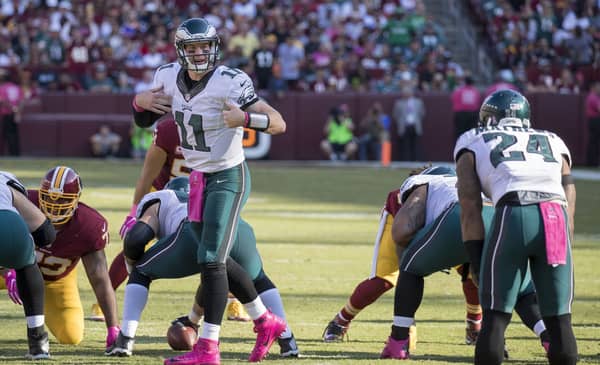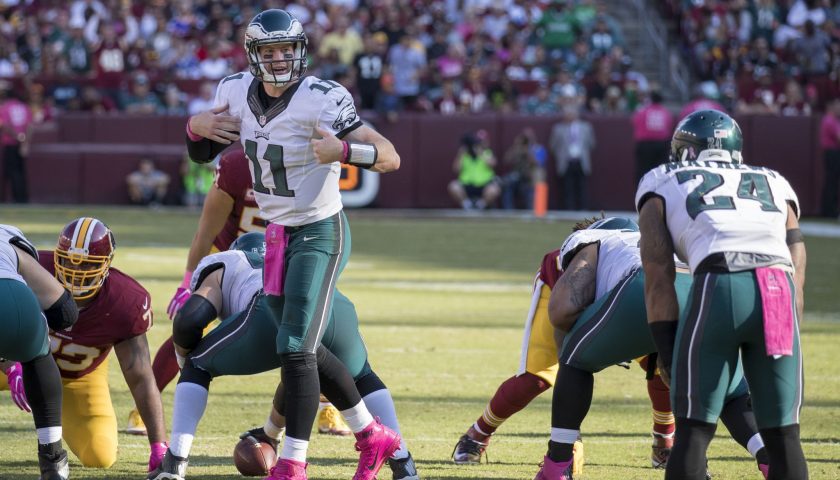

Philadelphia Eagles Quarterback Carson Wentz Playing Against The Washington Redskins. Photo Credit: Keith Allison – Under Creative Commons License
With training camps fully underway, NFL teams are starting to truly take stock of their rosters. Thanks to a hard salary cap and roster limits, it’s next to impossible for any team to construct a roster without at least a glaring hole somewhere. After a handful of down years, the NFC East appears ready to regain a measure of respect and, in a tightly packed division, each team’s weakness could prove to be the difference between finishing first and last.
What flaws will other teams be looking to exploit once the games start for real? These are the potential Achilles heel for all four NFC East teams.
Dallas Cowboys — Cornerback
Yes, left guard is a concern after the team moved La’el Collins to right tackle and with Ronald Leary (lost in free agency to the Broncos) and Doug Free (retired) no longer on the team. However, the Cowboys still have Tyron Smith, Travis Frederick and Zack Martin anchoring the rest of the offensive line, so the guess here is that whoever wins the starting job at left guard will be just fine.
Last season, however, Dallas was able to count on its secondary as the strength of the defense. After losing Brandon Carr, Morris Claiborne, as well as safeties Barry Church and J.J. Wilcox, in free agency, the Cowboys will be sporting a retooled defensive backfield in 2017.
The main free agent acquisition is Nolan Carroll, who was borderline horrible for the Philadelphia Eagles last season. The team addressed the position in the draft, but even though rookie Chidobe Awuzie has looked good thus far, relying on him and fellow rookie Jourdan Lewis is a big ask. Orlando Scandrick is still around to handle the slot, while Byron Jones and Jeff Heath have plenty of experience in the defense at the safety spots. If the defensive line can’t generate consistent pressure, however, the new starters at cornerback are going to get a tortuous workout every game.
New York Giants — Offensive line
True, the Giants’ stable of running backs — Paul Perkins, Shane Vereen, Wayne Gallman, etc. — don’t exactly strike fear into the hearts of opposing defensive coordinators (at least, not yet in the case of Gallman), but with head coach Ben McAdoo calling the shots, there isn’t going to be a lot asked of the running game regardless. The team has invested heavily in providing more weapons for Eli Manning beyond just Odell Beckham Jr. with the free agent signing of Brandon Marshall and using a first round pick on tight end Evan Engram.
What could’ve helped Manning, even more, would’ve been to add a veteran presence up front to make sure that he stays upright. While they’re still young, starting tackles Ereck Flowers (left) and Bobby Hart (right) had terrible seasons in 2016, where they were repeatedly treated like turnstiles by the league’s better defensive ends.
The team resigned right guard John Jerry, who’s been inconsistent throughout his career, and grades out as “adequate.” Left guard Justin Pugh and center Weston Richburg are better, but that’s damning with really faint praise.
Free agency brought San Diego first round bust D.J. Fluker into the mix — a move that did nothing to quell the fears of Giants’ fans. The team has young players in backup roles, whom they like, and both Flowers and Hart have shown some improvement so far in training camp, but if the team can’t keep pressure off of Eli, the close wins that made them a playoff team last year could quickly become losses.
Philadelphia Eagles — Cornerback
Last season, Philly put rookie quarterback Carson Wentz in a near impossible situation. Besides thrusting its presumptive franchise QB into a starting role just before Week 1, after trading away Sam Bradford to the Vikings, the Eagles saddled Wentz with a wide receiving corps that was laughably bad. The team spent most of the off-season addressing that inadequacy, though, signing free agents Alshon Jeffery and Torrey Smith and taking a pair of receivers (Mack Hollins and Shelton Gibson) in the middle rounds of the draft.
The Eagles’ cornerbacks were every bit as bad as the wide receivers last season, but unlike on the offensive side of the ball, the team did virtually nothing to address the situation. Starters Nolan Carroll and Leodis McKelvin were both sent packing after the season, and the only veteran of note who was brought in to replace them was journeyman Patrick Robinson, who has been consistently beaten by undrafted free agents during his first training camp with the team.
The hope is that second round draft pick Sidney Jones will eventually take over one side, but after tearing his Achilles tendon during pre-draft workouts, that’s not likely to happen this year.
The team has a strong set of safeties with starters Malcolm Jenkins and Rodney McLeod, along with recently signed backup Corey Graham, who will help patrol the middle of the field. Outside of the numbers, though, Philadelphia might be looking at second-year players Jalen Mills and C.J. Smith, or possibly third-round rookie Rasul Douglas, as the starters.
Mills showed flashes last year when pressed into duty as a rookie, and Smith has the kind of grit that might endear him to defensive coordinator Jim Schwartz, eventually. Barring an addition by trade or after rosters are pared down, however, there’s a good bet that opposing quarterbacks will look forward to playing the Eagles this season.
Washington Redskins — Wide Receiver
Perhaps no team in the NFL is more ready to have the season start than the Redskins. Washington’s tumultuous off-season has seen the departure of general manager Scott McCloughan and, not coincidentally, the team once again bungling the contract negotiations with starting quarterback Kirk Cousins. Despite his messy contract status, Cousins coming back under the franchise tag for another year at least gives Washington a leg up with the most important position on the field.
The squad’s weak spot, though, is a toss-up among the position groups surrounding the quarterback. There’s a good chance that running back might be worst from a talent standpoint, but the running game wasn’t very good last year either. Robert Kelley, Chris Thompson and Matt Jones haven’t gotten markedly better, but there’s at least hope that fourth-round draft pick Samaje Perine can offer some improvement.
The team’s leadership, however, might have cut the legs out from under Cousins by allowing starting wide receivers DeSean Jackson and Pierre Garcon to sign with Tampa Bay and San Francisco, respectively. Both players totaled more than 1,000 yards receiving and stretched the field, allowing injury-prone tight end Jordan Reed to find soft coverage underneath. With the duo gone, and Reed already missing time in training camp, Cousins will have his work cut out for him.
Stepping into the void is free agent signee Terrelle Pryor, who experienced a breakout season last year in the abyss of the Cleveland Browns. Before last year’s 77 catches, though, the converted quarterback had totaled all of two career receptions. The team’s 2016 first round selection, Josh Doctson, has talent but missed almost all of last season with an Achilles injury. Slot receiver Jamison Crowder and his 67 receptions provide a little bit of a safety blanket, but if Pryor and Doctson can’t replicate at least some of Jackson and Garcon’s success, then Cousins’ contract will be the least of Washington’s worries.
